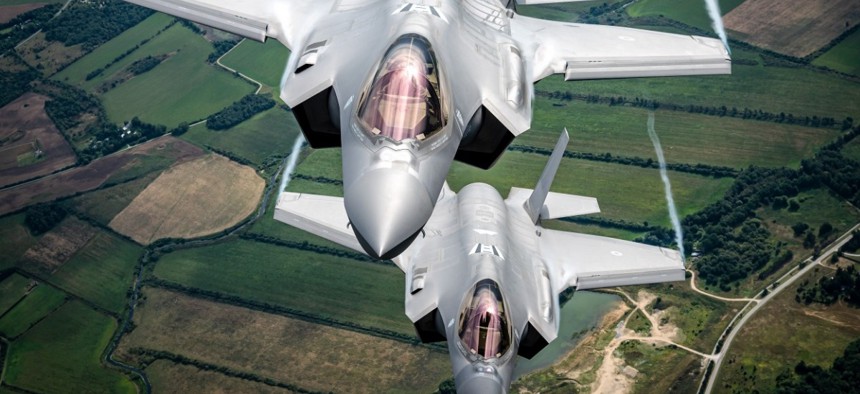
Italian F-35s fly over Estonia on a NATO Baltic Air Policing mission. NATO Allied Air Command / Giovanni Colla
Italy Is a Quiet Pillar of NATO’s Aerial Policing
Rome seems happy to contribute more than their share of ground troops and jets to NATO missions—as long as they can do it sotto voce.
The world has heard a great deal about the various weapons NATO member states are sending to Ukraine—and about the 5,000 helmets the Germans are sending. But it’s heard less, if anything, about Italy’s current policing of the skies above the Black Sea, its recent air policing in the Baltic skies, or for that matter its aircraft-carrier-based patrolling of the Mediterranean. Indeed, Italy has established itself as a stalwart of NATO’s various air policing programs. But because Rome rarely makes a fuss about the rotations, its hefty contribution flies largely under the radar.
Tensions are reaching a boiling point in Ukraine, and the Russian and Ukrainian parts of the Black Sea have become so dangerous that global insurers have redlisted them. Just a bit further south, the skies just off the Romanian coast are being patrolled by a quartet of Italian jets—first Eurofighters, now F-35s—along with aircraft of the Luftwaffe and Romanian Air Force. The mission is part of the Enhanced Air Policing effort launched by NATO after Russia annexed Crimea and helped separatists occupy eastern Ukraine.
“Italy is among the top contributors to NATO’s Air Policing mission across Europe, which is a strong sign of Italy’s capabilities and commitment to the alliance,” Manfred Reudenbach, a spokesman for NATO’s Allied Air Command, told me. “In addition to safeguarding the skies above Italy 24/365 with high-tech Eurofighters and F-35 fighter jets, the Italian Air Force regularly contributes to NATO Air Policing missions in the Baltic region and for our allies Iceland, Bulgaria, Slovenia, North Macedonia, and Montenegro.”
Italy has been a pioneer in the use of F-35s for NATO’s air policing missions; it was the first to fly the jets on patrols out of Iceland and Estonia, and last year notched the Baltic Air Policing mission’s first F-35 intercept.
Today, Italian F-35s are patrolling the Mediterranean from Italy’s Cavour aircraft carrier, a joint mission with strike groups built around France’s Charles De Gaulle carrier and the USS Harry S. Truman. Indeed, Italy is the only EU member state that has both an aircraft carrier and F-35s. France has a carrier but no F-35s, while the Netherlands and Norway have the planes but not the carrier. Germany, meanwhile, has neither.
Italy is a NATO aerial anchor, or perhaps one should say a maestro of the NATO skies.
“We’re doing a great amount. Iceland, the Baltics, the Black Sea,” said Vincenzo Camporini, a retired general who has been a combat pilot, chief of the Italian Air Force, and Chief of Defense. “We’re doing exactly what one would expect the Italian Air Force to do, and the same is true for our ground forces.”
Italy currently has nearly more than 9,000 armed forces personnel deployed on 34 missions in 21 countries, including 1,100 in Iraq and more than 600 in Kosovo. (Germany has some 3,000 soldiers deployed in 11 countries.)
“Most people don’t know that,” Donald Trump used to say after discovering a fact known to most people. In the case of Italy’s role in keeping NATO’s skies safe, though, it really is true that most people are unaware of it. Through no fault of their own, Italy’s pilots (and its ground troops) are, so to speak, flying under the radar.
“In Italian politics, there’s a long history of talking about soldiers of peace,” Camporini noted. “This is a legacy of the Cold War, when the Communist Party was very important, and it’s also a result of the role of the Church. The Pope is always talking about peace. I support that! But peace doesn’t mean disarmament. Unfortunately, our narrative hasn’t changed since the Cold War.”
NATO’s air raids against Serbia in the 1990s are a case in point. The bombings, conducted to halt Serbian aggression against minorities in Kosovo, featured more than 38,000 combat mission by allied pilots, including Italian ones.
“Our pilots were dropping bombs over Serbia and our politicians called it ‘integrated defense’,” Camporini recalled. “My pilots were very angry about it. I remember a wing commander telling me: ‘We’re risking our lives and nobody knows about it!’”
At one point during the Afghanistan war, when Camporini was Chief of Defense, Italian troops killed several Taliban fighters.
“I remember our minister of defense saying, ‘What happens if the public finds out about it?’” Camporini told me. “I said, ‘You can say we neutralized them’.”
With a political culture so averse to talk about military realities, it is perhaps unsurprising that Italian governments aren’t highlighting their country’s massive contributions to NATO air policing, even though the policing has so far not cost any lives. That doesn’t make Italy’s contributions in the air (or indeed on the ground) any less important. On the contrary, with NATO’s skies getting less friendly, the alliance needs air policing more than ever. In 2021, NATO fighter jets scrambled 370 times in response to intrusions or near-intrusions. Most of the intercepts took place in the Baltic skies, and 80 percent involved Russian aircraft.
Successive Italian governments seem to have decided that contributing to NATO air policing is simply what Italy does, just as it contributes a disproportionately large number of soldiers to a range of NATO, UN, and EU missions around the Mediterranean and beyond. The politicians seem to be fine with countless voters living in ignorance of this impressive feat. What matters more seems to be the fact that two essential constituencies are intimately familiar with it: NATO allies and NATO’s adversaries.




